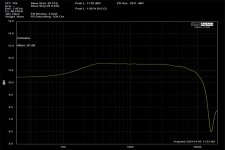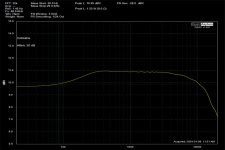If your design calls for a 5k - 5k Anode load, they are fine.
"With an anode to anode load of 4,000 Ω and 550 Volts on the anode a pair run in ultra linear AB1 will deliver 100 Watts at 3.5% distortion. With 425 Volts on the anodes and a load of 6,000 Ω the pair will generate 50 Watts at 2% distortion. If used connected as triodes in class A and with 425 Volts on the anodes and a load a - a of 6,000 Ω an output of 27 Watts at 1.3% distortion is obtained".
These will mismatch and give poor low end power with this loading.
Nothing wrong with the transformers, just not designed for this application.
"With an anode to anode load of 4,000 Ω and 550 Volts on the anode a pair run in ultra linear AB1 will deliver 100 Watts at 3.5% distortion. With 425 Volts on the anodes and a load of 6,000 Ω the pair will generate 50 Watts at 2% distortion. If used connected as triodes in class A and with 425 Volts on the anodes and a load a - a of 6,000 Ω an output of 27 Watts at 1.3% distortion is obtained".
These will mismatch and give poor low end power with this loading.
Nothing wrong with the transformers, just not designed for this application.
The high frequency issue was mostly due to the exaggerated amount of primary turns to get high inductance. Don't remember the core size but it was either a bad design or the core was too small for their target. The consequence of that was inefficiency due to large copper resistance and high leakage inductance which lead to poor frequency response. The current design has good balance in all aspects.
The full line of the better models of output transformers has been significantly improved and also the Studio Grade line of input transformers is very good.
These are single ended OT...If your design calls for a 5k - 5k Anode load, they are fine.
"With an anode to anode load of 4,000 Ω and 550 Volts on the anode a pair run in ultra linear AB1 will deliver 100 Watts at 3.5% distortion. With 425 Volts on the anodes and a load of 6,000 Ω the pair will generate 50 Watts at 2% distortion. If used connected as triodes in class A and with 425 Volts on the anodes and a load a - a of 6,000 Ω an output of 27 Watts at 1.3% distortion is obtained".
These will mismatch and give poor low end power with this loading.
Nothing wrong with the transformers, just not designed for this application.
stephe,
I tested that version, 5K, single ended, the 11 pound version (not the earlier made 5 or 6 pound version).
I was not aware that there is now a new version (3 versions over the years).
I used a Rohde and Schwarz Vector Network Analyzer at my work.
Tested from 10Hz to 100kHz.
No DC current, small signal only.
Driven by 1k Ohm, it was only down 1 dB at 10 Hz.
It started rolling off before 10kHz, perhaps at 5kHz, I can not remember.
I will have to look for that old graph I printed out years ago.
It should work good in an SE amplifier to drive a subwoofer.
Do not tell anybody . . .
I took a Dyna Stereo 70 Output transformer, removed the end bells, then the 2 wooden wedges between the inside of the coil structure and the laminations.
Then I separated the interleaved Es and Is, and re-stacked the laminations in Es at one end, and Is at the other end, with a Teflon tape "Air Gap".
Single ended, with 20%, 50%, and 80% UL the P, UL, CT, UL, P taps, if you choose to use them that way (I did).
I tested that version, 5K, single ended, the 11 pound version (not the earlier made 5 or 6 pound version).
I was not aware that there is now a new version (3 versions over the years).
I used a Rohde and Schwarz Vector Network Analyzer at my work.
Tested from 10Hz to 100kHz.
No DC current, small signal only.
Driven by 1k Ohm, it was only down 1 dB at 10 Hz.
It started rolling off before 10kHz, perhaps at 5kHz, I can not remember.
I will have to look for that old graph I printed out years ago.
It should work good in an SE amplifier to drive a subwoofer.
Do not tell anybody . . .
I took a Dyna Stereo 70 Output transformer, removed the end bells, then the 2 wooden wedges between the inside of the coil structure and the laminations.
Then I separated the interleaved Es and Is, and re-stacked the laminations in Es at one end, and Is at the other end, with a Teflon tape "Air Gap".
Single ended, with 20%, 50%, and 80% UL the P, UL, CT, UL, P taps, if you choose to use them that way (I did).
Last edited:
Thanks! and I was afraid it would be weak on the top end...stephe,
I tested that version, 5K, single ended, the 11 pound version (not the earlier made 5 or 6 pound version).
I was not aware that there is now a new version (3 versions over the years).
I used a Rohde and Schwarz Vector Network Analyzer at my work.
Tested from 10Hz to 100kHz.
No DC current, small signal only.
Driven by 1k Ohm, it was only down 1 dB at 10 Hz.
It started rolling off before 10kHz, perhaps at 5kHz, I can not remember.
I will have to look for that old graph I printed out years ago.
It should work good in an SE amplifier to drive a subwoofer.
Do not tell anybody . . .
I took a Dyna Stereo 70 Output transformer, removed the end bells, then the 2 wooden wedges between the inside of the coil structure and the laminations.
Then I separated the interleaved Es and Is, and re-stacked the laminations in Es at one end, and Is at the other end, with a Teflon tape "Air Gap".
Single ended, with 20%, 50%, and 80% UL the P, UL, CT, UL, P taps, if you choose to use them that way (I did).
The HF issues don't appear on the 4 ohm tap. I always assumed the cause was the unique secondary arrangements. Below are two recent curves showing the 1 watt response of the original 1628SE driven UL mode by and 828.The high frequency issue was mostly due to the exaggerated amount of primary turns to get high inductance.
Attachments
I measured the inductance of an older Hammond 1640SE (Z 1250 Ohm) here at 27 Henry (at 55V on full primary). The newer 1640SEA (Z 1250 Ohm) is spec'd at 14 Hy.
The newer 1627SEA (Z 2500 Ohm) is spec'd at 20 Hy.
.
I measured the 1640SE freq. response using a scope and osc.:
8 Ohm output with 8 Ohm load:
V: 90% 14.5 KHz
.866 16.5 KHz
.707 22 KHz
.5 28 KHz
and 16 Ohm output with 16 Ohm load:
V: 90% 13.5 KHz
.866 17.5 KHz
.707 23.8 KHz
.5 32 KHz
1st minimum valley at 36 KHz ( primary resonance )
The newer 1627SEA (Z 2500 Ohm) is spec'd at 20 Hy.
.
I measured the 1640SE freq. response using a scope and osc.:
8 Ohm output with 8 Ohm load:
V: 90% 14.5 KHz
.866 16.5 KHz
.707 22 KHz
.5 28 KHz
and 16 Ohm output with 16 Ohm load:
V: 90% 13.5 KHz
.866 17.5 KHz
.707 23.8 KHz
.5 32 KHz
1st minimum valley at 36 KHz ( primary resonance )
Last edited:
Probably not relevant for you
I have an older 1627SEA
Icould test and calculate the inductance for you.
I have an older 1627SEA
Icould test and calculate the inductance for you.
Yes, please do. Three years ago I ran the top Level 3 O'Netics 2500R SE OPT on a breadboard 2A3, although the upper mids and highs were very good, I thought it was lacking from the lower mids through the bass. An OEm friend suggested trying the Hammond 1627SEA. The O'Netics now resides on the other side of the planet!
There don't seem to be very many alternative options to the Hammond transformer, as a lot of audio transformer manufacturers have packed up and exited "stage left". It may be time toe try Edcor, even though you have to wait a long time for the finished product. Another option would be Musical Power Supplies, though their 5k impedance single ended offering might be underpowered for your needs.
Last edited:
So sad - I just checked out their web site, and Thermionic Lab is charging in Euros for their iron - shipping will be expensive... Oh, and Jcalvarez - thanks for the totally unnecessary snark - I'm the one who has to pay for shipping iron from the UK, not you, so it's my decision alone to make.
- Home
- Amplifiers
- Tubes / Valves
- Consensus on the Hammond 1628SEA?

